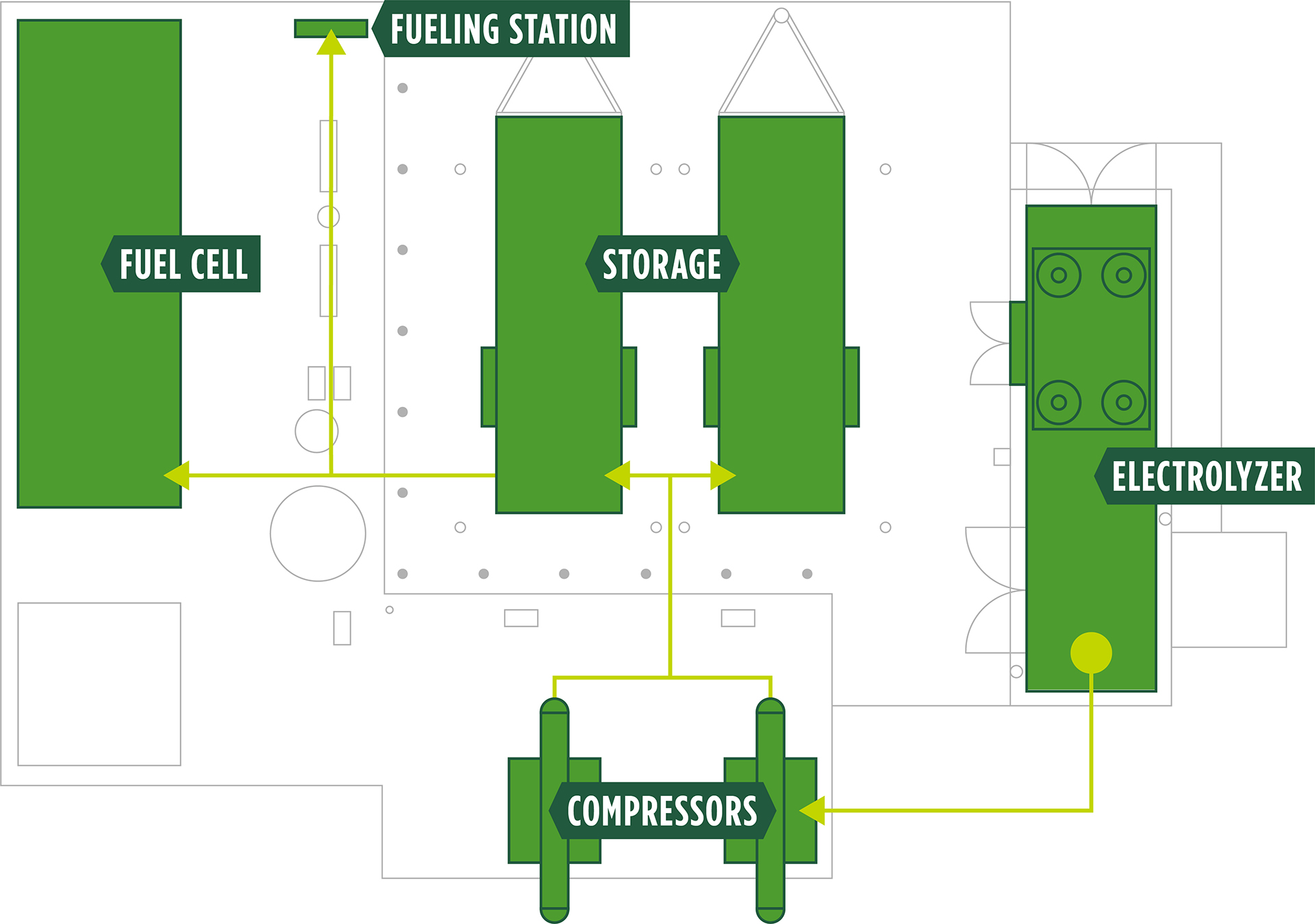
Layout considerations for the OUC hydrogen demonstration project.
Taking steps toward reducing carbon footprints and increasing sustainability requires careful planning, integration and innovative solutions using state-of-the-art technologies. As organizations look to diversify their energy portfolios, a clear objective endures: delivering reliable, affordable energy.
✖

Designing and building the infrastructure to support a renewables-driven strategy requires creative collaboration. This mindset is exactly what the Orlando Utilities Commission (OUC), a municipal utility in Central Florida, is using to pilot hydrogen technologies.
In an effort to meet its 2050 goal of net zero carbon emissions, OUC is developing a hydrogen technology demonstration project. Mitigating the intermittency of solar power is just one of the challenges the project is designed to address. The project will also offer insight and a better understanding for OUC engineers on how hydrogen technology can serve as a major player in meeting future renewable goals. The combination of technologies being piloted, if scaled appropriately with enough hydrogen storage, could potentially provide weeks’ worth of energy storage.
“The versatility of the fuel really provides a lot of capability,” says Justin Kramer, manager of emerging technologies at OUC. “Hydrogen is like the Swiss Army knife of storage. Using hydrogen as storage and in other capacities is one way that OUC can reach its goal of net zero carbon emissions by 2050.”
For this green hydrogen project, Burns & McDonnell has been hired to provide front-end engineering for plant integration. This includes electrical engineering, instrumentation and controls engineering, civil/structural engineering, mechanical engineering and system design, permitting support, budgetary estimate support, and owner’s engineering services.
Unique project components include a hydrogen system that can produce, store and utilize the gas to generate electricity, as well as hydrogen fueling stations for fleet vehicles. The system will feature an electrolyzer for hydrogen production, hydrogen compressor skids, tube trailers for hydrogen storage and dispensing, hydrogen fueling stations for fuel cell electric vehicle fueling, a fuel cell for electricity production, a water recovery system, and a 1,500-kVA transformer for power delivery.


Layout considerations for the OUC hydrogen demonstration project.
“Hydrogen hubs are increasingly being discussed across the U.S. as a solution in meeting renewable goals,” says Dave Guinta, manager of process technology at Burns & McDonnell. “As we look ahead, this is just a microcosm of what green hydrogen usage could look like in the future, and we are proud to help support OUC’s forward-thinking approach to developing zero-carbon generation assets.”
Final construction and installation for the project is expected to wrap in late 2022. This will be followed by a period of one or two years in which OUC will review results and evaluate how larger-scale hydrogen projects could help meet renewable power goals.
As other utilities and organizations weigh their options when it comes to implementation of future hydrogen technology, one major anticipated obstacle is the amount of funding available for project completion. Funding for the OUC hydrogen demonstration project came from a $4 million grant from the U.S. Department of Energy, part of a $40 million federal initiative for hydrogen projects.
“With the new Infrastructure Investment and Jobs Act that was signed into law in late 2021, funding opportunities will likely become available for future hydrogen projects,” says Tisha Scroggin-Wicker, director of process technology at Burns & McDonnell. “While it could take some time to determine how and when funding will be awarded, putting in place a plan for future hydrogen projects as soon as possible is a step utilities can take now that should position them nicely for the opportunities to come.”
✖
Thought Leaders

Dave Guinta, PE
Section Manager
Burns & McDonnell

Tisha Scroggin-Wicker, PE
Decarbonization Director
Burns & McDonnell
Related Content
Blog
New Hues Turning Hydrogen Rainbow Into Hydrogen Kaleidoscope
Burns & McDonnell
White Paper
Exploring the Future Role of Hydrogen in a Decarbonized Power Industry
Burns & McDonnell
Webinar
Exploring Hydrogen’s Role in a Decarbonized Economy
Burns & McDonnell
Blog
Hydrogen Supports Diversified Energy Asset Portfolios
Burns & McDonnell
Load More


.png)
BenchMark is an international award-winning news source published by Burns & McDonnell. Since 1926, it has served as an innovative, forward-thinking and solutions-driven resource for communities and industries around the world.
©2025 Burns & McDonnell All Rights Reserved.